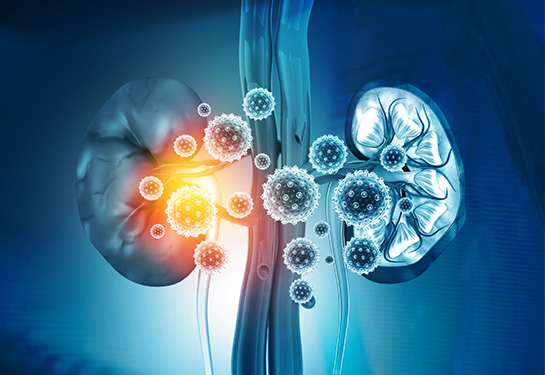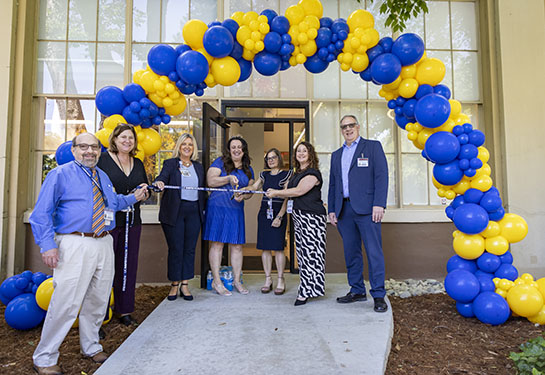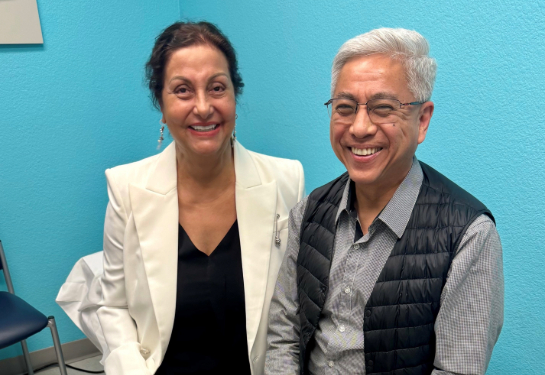Nephrology researchers shining a light on chronic kidney disease
Team investigating therapeutics and lifestyle interventions to improve physical function and physical performance of patients living with chronic kidney disease
Nephrology researchers at UC Davis Health are shining a light on chronic kidney disease (CKD) as they investigate treatment options for impaired physical performance and exercise intolerance in chronic kidney disease patients.
Led by Baback Roshanravan, associate professor of medicine and the Paul F. Gulyassy endowed professor in nephrology, the researchers are conducting three separate NIH funded clinical studies analyzing the effects of therapeutics and lifestyle interventions on the metabolic and physical health of patients suffering from chronic kidney disease.
Chronic kidney disease is common: 15% of the United States population or one in seven people suffers from the disease according to the Centers for Disease Control and Prevention (CDC). Fatigue is one of the most common symptoms experienced by patients with chronic kidney disease.
With chronic kidney disease, the kidneys are damaged and cannot filter blood as well as they should. Because of this, excess fluid and waste from blood remain in the body and may cause additional health problems. These include inflammation and the build-up of acid and toxins, causing insulin resistance and increasing the risk of cardiovascular disease and frailty.
A common problem for patients with chronic kidney disease is a loss of muscle mass and strength, which impacts the activities of daily living.
“We have seen that many middle-aged patients with chronic kidney disease physically function at the level of octogenarians,” said Roshanravan, who has spent his career investigating the links between altered metabolism in chronic kidney disease with muscle function, physical functioning, and frailty.
“There are 37 million Americans with chronic kidney disease and the vast majority don’t even know it because there are typically no or few symptoms in the early stages of the disease — so it is imperative we work to develop treatments to improve their quality of life and decrease their risk of progression to kidney failure requiring dialysis,” he added.
CoNR trial
Roshanravan and his team recently completed a study on the impact of coenzyme Q10 (CoQ10) and nicotinamide riboside (NR) on exercise tolerance and metabolic profile in chronic kidney disease patients. The work was funded by the National Institutes of Diabetes and Digestive Kidney Diseases.
They published their research in The Journal of Clinical Investigation.
The team conducted a randomized placebo-controlled trial comparing CoQ10, NR, and placebo in 25 patients. Participants received NR (1000 mg/day), CoQ10 (1200 mg/day) and placebo separately for 6-week treatment periods in a random order. Neither the participants nor the researchers knew who got the treatments and who got the placebo.
Researchers tested the impacts of CoQ10 and NR on physical endurance and muscle work efficiency by putting the participants through bicycle cardiopulmonary exercise testing and measuring their maximal and submaximal rate of oxygen consumption.
To measure the participants’ metabolisms, they performed semi-targeted plasma metabolomics and lipidomics.
Results of the study showed:
- Use of CoQ10 and NR is safe in patients with chronic kidney disease.
- There were no differences in maximal rate of oxygen consumption and total work efficiency with CoQ10 or NR.
- NR did show improvement of muscle work efficiency during biking at lower workloads after six weeks of treatment compared to placebo. In other words, they were producing the same work output but using less oxygen at submaximal levels of intensity.
- NR showed improvement in carbohydrate utilization during submaximal exercise.
- Compared to the placebo, treatment with either CoQ10 or NR showed systemic improvements in markers of mitochondrial metabolism and lipid profiles.
- NR decreased a broad range of lipid groups including triglycerides and toxic ceramides that have been associated with inflammation and progressive kidney function decline in large studies.
“The fact that we did see some short-term improvements in muscle work efficiency at lower levels of workloads suggests that trials of longer duration may be needed to observe improvements in peak performance,” Roshanravan said.
However, he added that he now believes treating impaired physical performance in chronic kidney patients will require more than just pharmacologic therapeutic options.
“A pill will never be the panacea for improving physical performance of patients living with chronic kidney disease,” he said. “Our focus has really changed toward lifestyle interventions that will improve physical performance.”
A pill will never be the panacea for improving physical performance of patients living with chronic kidney disease. Our focus has really changed toward lifestyle interventions that will improve physical performance.” —Baback Roshanravan
ESTEEM study
To better understand the effect exercise has on muscle energy production in people with kidney disease, Roshanravan and his team began the ESTEEM study during the COVID pandemic. Their goal was to find out if a supervised home exercise program might improve how well the kidneys work and see if exercise improves the ability to perform physical tasks.
Researchers are enrolling 40 participants with chronic kidney disease both with and without diabetes in the study. Participants will randomly receive either a virtual, personalized and home-based exercise training program or their usual care without the exercise program. Those not included in the exercise group will receive free fitness testing, continuous glucose monitoring and consultations after the study is concluded. The exercise program was developed in collaboration with Gwenaelle Begue, a professor of exercise physiology at California State University, Sacramento.
“This project is a real testament to the multidisciplinary collaboration at UC Davis and our collaborator at Sacramento State University,” Roshanravan explained.
Team members include:
- Craig McDonald, chair of physical medicine and rehabilitation
- Thomas Jue, professor of biochemistry and molecular medicine
- Lucas Smith, assistant professor of physical medicine and rehabilitation
- Tae Youn Kim, professor at Betty Irene Moore School of Nursing
- Brian Bennett, associate adjunct professor of nutrition
“We are particularly grateful for the support of Dr. McDonald and his team for performing all exercise testing, ensuring patients can exercise safely at home.”
To determine the program’s impact, researchers will use leg muscle biopsies and MRI scans to compare muscle metabolism and muscle function in those who were assigned to the exercise program and those who were not.
“Our interim analysis suggests compelling improvements in muscle mitochondrial function from muscle biopsies of patients enrolled in our home exercise program,” Roshanravan said. “We are also seeing improvements in physical endurance on six-minute walk distance testing and total muscle work output on bicycle cardiopulmonary exercise testing.”
Researchers plan to continue recruiting for the study through the end of the summer. They’ll then transition to their multicenter NIDDK-funded clinical trial, extending the intervention to patients with end stage kidney disease (patients treated with dialysis) at UC Davis and Vanderbilt University medical centers.
Senergy-CKD study
Researchers are also conducting a clinical trial to look at how correcting the acid accumulation in the body when the kidneys shut down improves exercise tolerance and insulin resistance.
“Acid accumulation can lead to muscle mitochondrial dysfunction, leading to insulin resistance, muscle low endurance, and ultimately muscle atrophy”, Roshanravan explained. “We will test if giving sodium bicarbonate to correct acid accumulation improves insulin resistance and cardiometabolic risk factors of chronic kidney disease and how that translates into changes in exercise tolerance.”
In this separate NIDDK-funded study at multiple sites, researchers will compare sodium bicarbonate to placebo in a randomized, cross-over trial. The study will include 80 people with moderate to severe chronic kidney disease and metabolic acidosis from UC Davis and Vanderbilt University medical centers.
In this study each participant will undergo four months of treatment with a placebo followed by four months of sodium bicarbonate in a random sequence. Investigators will study if sodium bicarbonate improves the ability of the body to use glucose, improves physical performance, and improves muscle mitochondrial function. They will measure muscle mitochondrial function using a special form of MRI detecting changes in muscle biochemistry with exercise called Phosphorus Magnetic Resonance Spectroscopy and muscle biopsy.
“We anticipate the strategies treating metabolic acidosis will improve exercise tolerance for participants,” Roshanravan said. “This will enable participants to more effectively engage in lifestyle interventions and improve their quality of life with chronic kidney disease.”






